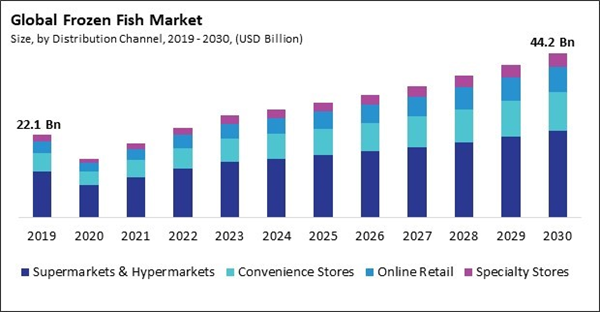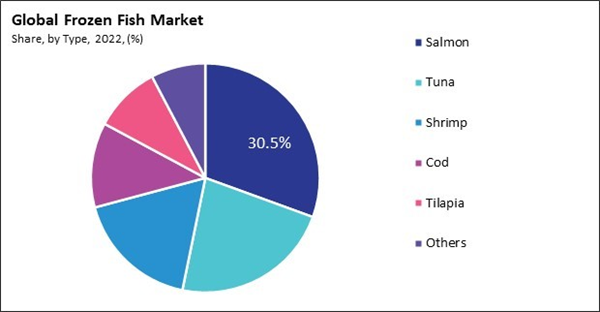The Global Frozen Fish Market size is expected to reach $44.2 billion by 2030, rising at a market growth of 7.1% CAGR during the forecast period. In the year 2022, the market attained a volume of 910.4 kilo tonnes, experiencing a growth of 4.5% (2019-2022).
Cod's mild flavor and flaky texture make it versatile in various culinary applications. From classic fish and chips to fish tacos, cod adapts well to different cooking methods and complements various flavors. Consequently, the Cod segment would generate approximately 12.51 % share of the market by 2030. Also, Spain would consume 6.6 kilo tonnes of tilapia by 2030. Its versatility appeals to home cooks and chefs, driving the demand for frozen cod products. Processed cod products, such as breaded and battered cod fillets, fish fingers, and cod cakes, have gained popularity within the market.
With higher disposable incomes, consumers are more willing to invest in premium and high-quality food products, including premium varieties of frozen fish. This willingness to spend on quality items expands the premium market, increasing sales. Consumers with higher disposable incomes may be more inclined to explore seafood options, including fish species and specialty frozen fish products. Therefore, the market is expanding significantly due to the higher level of disposable income.
Additionally, E-commerce platforms allow people to browse and purchase frozen fish products from the comfort of their homes. This eliminates the need for in-store visits, delivering a convenient and time-saving shopping experience for busy individuals and families. Thus, because of the growing e-commerce and online retail channels, the market is anticipated to increase significantly.
However, Pricing strategies play a crucial role in maintaining competitiveness in the market. Intense competition may lead to aggressive pricing, affecting profit margins for frozen fish producers. Striking a balance between competitive pricing and sustaining profitability is an ongoing problem. Thus, high-cost pressures and pricing strategies can slow down the growth of the market.
Cod's mild flavor and flaky texture make it versatile in various culinary applications. From classic fish and chips to fish tacos, cod adapts well to different cooking methods and complements various flavors. Consequently, the Cod segment would generate approximately 12.51 % share of the market by 2030. Also, Spain would consume 6.6 kilo tonnes of tilapia by 2030. Its versatility appeals to home cooks and chefs, driving the demand for frozen cod products. Processed cod products, such as breaded and battered cod fillets, fish fingers, and cod cakes, have gained popularity within the market.
With higher disposable incomes, consumers are more willing to invest in premium and high-quality food products, including premium varieties of frozen fish. This willingness to spend on quality items expands the premium market, increasing sales. Consumers with higher disposable incomes may be more inclined to explore seafood options, including fish species and specialty frozen fish products. Therefore, the market is expanding significantly due to the higher level of disposable income.
Additionally, E-commerce platforms allow people to browse and purchase frozen fish products from the comfort of their homes. This eliminates the need for in-store visits, delivering a convenient and time-saving shopping experience for busy individuals and families. Thus, because of the growing e-commerce and online retail channels, the market is anticipated to increase significantly.
However, Pricing strategies play a crucial role in maintaining competitiveness in the market. Intense competition may lead to aggressive pricing, affecting profit margins for frozen fish producers. Striking a balance between competitive pricing and sustaining profitability is an ongoing problem. Thus, high-cost pressures and pricing strategies can slow down the growth of the market.
By Type Analysis
By type, the market is categorized into salmon, tuna, cod, tilapia, shrimp, and others. In 2022, the salmon segment held the 30.53 % revenue share in the market. In terms of volume, Cod segment would register 65.9 kilo tonnes in 2022. Omega-3 fatty acids are abundant in salmon and beneficial to heart health. For instance, the Food and Agriculture Organization of the United Nations (FAO) estimates that salmon exports, led by Chile and Norway, were valued at USD 27.6 billion in 2020. In 2020, exports of salmon and trout made up 18.4% of the total value of aquatic products exported.By Distribution Channel Analysis
Based on distribution channel, the market is classified into supermarkets & hypermarkets, convenience stores, specialty stores, and online retail. The online retail segment acquired a 14.61 % revenue share in the market in 2022. Online retail provides unparalleled convenience, allowing consumers to browse, select, and purchase frozen fish products from the comfort of their homes. From individual fillets and seafood blends to specialty frozen fish dishes, consumers can choose from an extensive assortment that may not be available in traditional brick-and-mortar stores.By Regional Analysis
Region-wise, the market is analysed across North America, Europe, Asia Pacific, and LAMEA. In 2022, the North America region acquired a 21.05 % revenue share in the market. Growing health consciousness among North American consumers has led to an increased focus on incorporating nutritious foods into their diets. With its diverse cultural landscape, North America has many culinary preferences. The market in North America has responded by incorporating sustainable practices, such as responsible fishing methods and eco-friendly packaging, to meet the demands of environmentally conscious consumers. Ongoing innovation in frozen fish products has been crucial in attracting North American consumers.List of Key Companies Profiled
- Dongwon Enterprises Co. Ltd.
- Mowi ASA
- Zoneco Group Co., Ltd.
- F.C.F. Fishery Co., Ltd.
- Nippon Suisan Kaisha, Ltd.
- Chicken of the sea International (Thai Union Group PLC)
- Nueva Pescanova, S.L (Abanca Corporación Bancaria, S.A.)
- Tassal Group Limited
- High Liner Foods
- SalMar ASA (Kvera AS)
Market Report Segmentation
By Distribution Channel (Volume, Kilo Tonnes, USD Billion, 2019-2030)- Supermarkets & Hypermarkets
- Convenience Stores
- Online Retail
- Specialty Stores
- Salmon
- Tuna
- Shrimp
- Cod
- Tilapia
- Others
- North America
- US
- Canada
- Mexico
- Rest of North America
- Europe
- Germany
- UK
- France
- Russia
- Spain
- Italy
- Rest of Europe
- Asia Pacific
- China
- Japan
- India
- South Korea
- Singapore
- Malaysia
- Rest of Asia Pacific
- LAMEA
- Brazil
- Argentina
- UAE
- Saudi Arabia
- South Africa
- Nigeria
- Rest of LAMEA
Table of Contents
Chapter 1. Market Scope & Methodology
Chapter 2. Market at a Glance
Chapter 3. Market Overview
Chapter 4. Global Frozen Fish Market, by Distribution Channel
Chapter 5. Global Frozen Fish Market, by Type
Chapter 6. Global Frozen Fish Market, by Region
Chapter 7. Company Profiles
Companies Mentioned
- Dongwon Enterprises Co. Ltd.
- Mowi ASA
- Zoneco Group Co., Ltd.
- F.C.F. Fishery Co., Ltd.
- Nippon Suisan Kaisha, Ltd.
- Chicken of the sea International (Thai Union Group PLC)
- Nueva Pescanova, S.L (Abanca Corporación Bancaria, S.A.)
- Tassal Group Limited
- High Liner Foods
- SalMar ASA (Kvera AS)
Methodology

LOADING...










